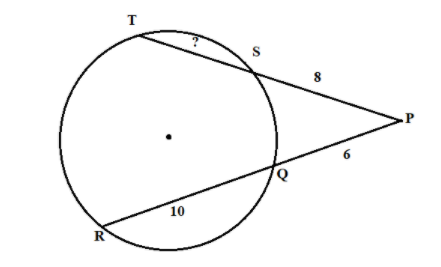
Find the length of $TS$ if $PQ = 6$, $QR = 10$, $PS = 8$.


Answer
584.7k+ views
Hint: Check out the figure carefully and observe that the chords meet externally or internally, if the chord of the circle intersects externally then the products of the segments of the chords are equal.
Complete step-by-step answer:
Given: $PQ$ is given $6$, $QR$ is given 10, $PS$ is given $8$
To find: we have to find the value of $TS$.
By property of external division of chords, if the chord of the circle intersects externally then the products of the segments of the chords are equal.
In simple words the multiplication of $QR$ and $PR$ will always be equal to the multiplication of $PS$ and $PT$.
That is, $PQ \times PR = PS \times PT$
As, we have given $PQ = 6$
And
$
PR = PQ + QR \\
PR = 6 + 10 \\
$
Hence on simplifying,
$PR = 16$ $
PQ \times PR = PS \times PT \\
\Rightarrow 6 \times 16 = 8 \times {\text{PT}} \\
$
We have given $PS = 8$
As we have to find the value of $TS$, where $TS$ is included in the length $PT$
Where, $PT = TS + PS$
So first we have to find $PT$.
Now, let us find $PT$ by substituting the obtained values in $PQ \times PR = PS \times PT$.
Simplify the obtained expression for $PT$.
$
\dfrac{{6 \times 16}}{8} = {\text{PT}} \\
\Rightarrow 12 = {\text{PT}} \\
$
We have $PT$ but we have to find TS. If we see the figure, we can easily observe that $PT = TS + PS$.
We have values of $PS$ and $PT$ as $8$ and 12 respectively.
Now we will substitute the values.
\[
{\text{PS + TS = PT}} \\
\Rightarrow {\text{8 + TS = 12}} \\
\Rightarrow {\text{TS = 12 }} - {\text{ 8 }} \\
{\text{ = 4}} \\
\]
Hence, the required value of $TS$ is 4.
Note: We have applied the property of external division of chords initially and found the value of $PT$ by applying this property then we found the value of $TS$ by subtracting $PS$ from $PT$ according to figure.
Complete step-by-step answer:
Given: $PQ$ is given $6$, $QR$ is given 10, $PS$ is given $8$
To find: we have to find the value of $TS$.
By property of external division of chords, if the chord of the circle intersects externally then the products of the segments of the chords are equal.
In simple words the multiplication of $QR$ and $PR$ will always be equal to the multiplication of $PS$ and $PT$.
That is, $PQ \times PR = PS \times PT$
As, we have given $PQ = 6$
And
$
PR = PQ + QR \\
PR = 6 + 10 \\
$
Hence on simplifying,
$PR = 16$ $
PQ \times PR = PS \times PT \\
\Rightarrow 6 \times 16 = 8 \times {\text{PT}} \\
$
We have given $PS = 8$
As we have to find the value of $TS$, where $TS$ is included in the length $PT$
Where, $PT = TS + PS$
So first we have to find $PT$.
Now, let us find $PT$ by substituting the obtained values in $PQ \times PR = PS \times PT$.
Simplify the obtained expression for $PT$.
$
\dfrac{{6 \times 16}}{8} = {\text{PT}} \\
\Rightarrow 12 = {\text{PT}} \\
$
We have $PT$ but we have to find TS. If we see the figure, we can easily observe that $PT = TS + PS$.
We have values of $PS$ and $PT$ as $8$ and 12 respectively.
Now we will substitute the values.
\[
{\text{PS + TS = PT}} \\
\Rightarrow {\text{8 + TS = 12}} \\
\Rightarrow {\text{TS = 12 }} - {\text{ 8 }} \\
{\text{ = 4}} \\
\]
Hence, the required value of $TS$ is 4.
Note: We have applied the property of external division of chords initially and found the value of $PT$ by applying this property then we found the value of $TS$ by subtracting $PS$ from $PT$ according to figure.
Recently Updated Pages
Master Class 10 General Knowledge: Engaging Questions & Answers for Success

Master Class 10 Computer Science: Engaging Questions & Answers for Success

Master Class 10 English: Engaging Questions & Answers for Success

Master Class 10 Social Science: Engaging Questions & Answers for Success

Master Class 10 Maths: Engaging Questions & Answers for Success

Master Class 10 Science: Engaging Questions & Answers for Success

Trending doubts
The shortest day of the year in India

Why is there a time difference of about 5 hours between class 10 social science CBSE

Write a letter to the principal requesting him to grant class 10 english CBSE

What is the median of the first 10 natural numbers class 10 maths CBSE

The Equation xxx + 2 is Satisfied when x is Equal to Class 10 Maths

State and prove converse of BPT Basic Proportionality class 10 maths CBSE




